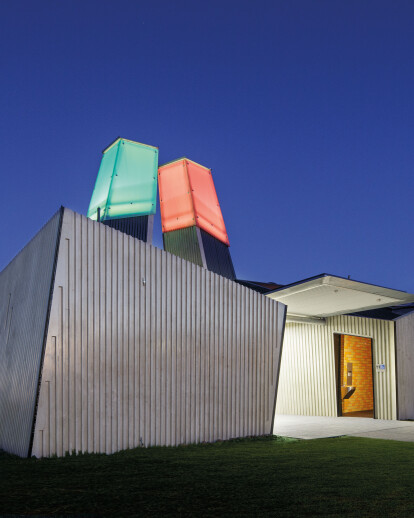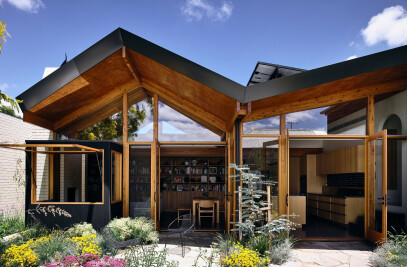It is estimated that driver fatigue is a factor in 20% of deaths on Victoria’s roads each year. In response to this VicRoads has developed a Victorian Rest Area Strategy which aims to reduce fatigue-related incidents by taking a holistic, strategic approach to the provision of rest areas across Victoria’s major roads. A key objective of this strategy is to provide interesting and engaging architecture to encourage drivers to stop and recuperate - to create places of interest beyond their utilitarian functions, with areas for people to eat and for children to play.
There is a long and rich history of the rest area within Australia. These places mark a point in a journey, a place for pausing, and a place for rest. They are an important part of the road trip psyche.
While fundamentally utilitarian, we consider these buildings to be important civic structures that are able to engender multiple readings and associations. On approach the rest area structure’s silhouette is reminiscent of a civic clock tower or a church spire. Set within the freeway landscape and read from afar, their scale is deceptive, appearing as odd follies cast aside from the roadway artery. As one moves closer however, the eight metre high, glowing glass towers become iconic and bold. Inside, the spaces are colourful and vibrant, providing a more intimate and tactile experience of the buildings.
This project elevates “the ordinary”, a freeway rest area and toilet block, to the iconic. It departs from pre-conceived ideas of what this type of facility should look like and celebrates instead a sense of playfulness and difference. The new buildings provide a strong identity and sense of place to their site, providing a clear point of differentiation from the repetition of the road, a place to pause.
Sustainable Architecture This entire rest area facility is off the grid. All power is generated from PV cells located above the car port structure, providing lighting and power for pumps and generators. While there is a backup mains water connection, a series of underground concrete tanks store water collected from the roofs to feed the toilet cisterns and hand basins.
The precast concrete chimney structures serve as natural ventilation for the facility eliminating the need for mechanical ventilation. Similarly, slots within the precast walls assist with airflow.
An onsite septic treatment also had to be used as there was no mains sewer to the site, which in turn provides treated water for a sub surface distribution system for landscape irrigation.
The integrated landscape design proposes a simple treatment of strategically located Eucalypts to provide a human scale to the buildings and more importantly shade for the users.
Materials have been selected inherent natural finish. Low maintenance is an important issue in these facilities and generally surfaces that require regular re-painting or application are discouraged. Natural finished concrete meets this requirement perfectly and has been utilised extensively throughout.








































